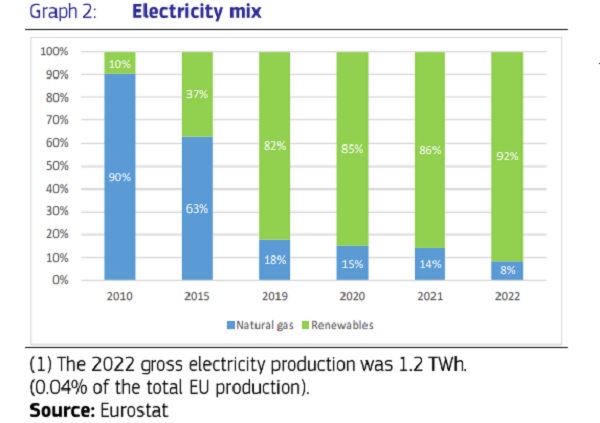 Luxembourg electricity mix figures;
Credit: Eurostat
Luxembourg electricity mix figures;
Credit: Eurostat
On Wednesday 11 September 2024, the European Commission published the State of the Energy Union Report 2024.
According to the Commission, this report describes how the European Union (EU) has managed "unprecedented" energy policy challenges during its mandate, providing the EU with a regulatory framework to deliver the clean energy transition and laying the foundations for renewed economic growth and competitiveness.
The report particularly shows how the EU has addressed in recent years critical risks to its security of energy supply, how it regained control of the energy market and prices, and how it accelerated the transition to climate neutrality, as follows:
- renewable energy generation is breaking new capacity records. In the first half of 2024, half of the EU's electricity generation came from renewable sources;
- the share of Russian gas in EU imports fell from 45% in 2021 to 18% in June 2024, while imports from trusted partners such as Norway and the United States have increased;
- the EU reduced gas demand by 138 billion cubic metres between August 2022 and May 2024;
- the EU reached its winter gas storage target of 90% on 19 August 2024, ahead of the 1 November deadline;
- energy prices are more stable and remain below the peak levels reached during the 2022 energy crisis;
- EU greenhouse gas emissions fell by 32.5% between 1990 and 2022, while the EU economy grew by around 67% over the same period;
- at international level, the EU led the global initiative to triple renewable energy capacity and double energy efficiency improvements as part of the transition away from fossil fuels, which was endorsed by all parties at COP28 in Dubai.
The Commission added that "significant" progress had been made in the field of renewables. Wind power has overtaken gas to become the EU's second largest source of electricity behind nuclear, and by the first half of 2024, renewables generated 50% of electricity in the EU. In 2022, the EU's primary energy consumption continued its downward trend, falling by 4.1%.
However, the Commission noted that energy efficiency efforts will still need to be stepped up for the EU to reach the 11.7% reduction target for final energy consumption by 2030. Further improvements are needed, especially regarding the electrification of all heating equipment and the renovation rate of buildings. It also acknowledged that more efforts are needed to address high energy prices, and thus to increase the competitiveness of EU industries and to accelerate investment in Europe's integrated infrastructure networks.
The report recalled that all EU Member States must finalise their updated National Energy and Climate Plans (NECPs) "as soon as possible", to enable the collective delivery of the 2030 energy and climate targets.
The Commission noted that new and emerging challenges will need to be addressed in the future, such as the current ambition gap in renewables and energy efficiency targets, increasing energy poverty, the energy price gap with other global competitors and the risk of new critical strategic dependencies.
The Commission added that the EU has continued to support Ukraine in the face of Russian attacks on its energy system. The synchronisation of the Ukrainian and Moldovan grids with the European continental grid has helped stabilise the Ukrainian electricity system and the capacity of electricity exchanges now reaches 1.7 GW for commercial trade. This synchronisation also allows Ukraine to benefit from emergency imports. As of 31 July 2024, more than 40% of Member States' grants were dedicated to the energy sector, with the total contribution of the Union Civil Protection Mechanism estimated at over €900 million. The Ukraine Energy Support Fund (UESF) also mobilised over €500 million by June 2024. In addition, the EU's €50 billion Ukraine Facility will provide "consistent" funding to support the country's recovery and sustainable economic growth until 2027.
The report also touches on strengthening energy security and competitiveness, as well as empowering consumers in the clean transition.
Luxembourg
The country-specific report showed that fossil fuels accounted for 86.7% of Luxembourg's energy mix (compared to 69%) at EU level; the share of renewables was 13.3%. It also revealed that the country's electricity mix was dominated by renewable energy with 91.6% (38.6% at EU level); natural gas accounted for the remaining 8.4%.
In terms of market integration, the report noted that Luxembourg has a high electricity smart metre rollout - 99% of household consumers were equipped with smart metres in 2023. Moreover, that same year, Belgium and Luxembourg had ten natural gas supply sources (i.e. the same as in 2021); Norway was the main supplier with a share of 33%.
Regarding the Social Climate Plan, the maximum financial allocation for Luxembourg was €73 million.
Luxembourg also had a total allocation of €239 million (only grants) for its Recovery and Resilience Plan, with 68.8% of available funds supporting climate objectives. The report added that €24 million were allocated to energy-related measures.
The full country-specific report is available as a PDF here.








